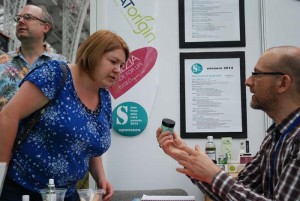Cosmetic Scientist Colin of Colin’s Beauty Pages has just posted a very interesting blog about an Australian brand’s particular product label. In it, he wonders about their marketing claims and imprecise use of the word chemical, but what interested us more was his point that the ingredients list seems needlessly overwritten — particularly with repeated use of the word PLANT in brackets after certain ingredients — especially fragrance allergens. This, he points out, can make it more difficult for those who need to avoid certain ingredients, to spot them in a (longer) list.
It’s easy to forget that ingredients lists haven’t always been compulsory on skincare products, and that their introduction was a huge help to those with allergies to cosmetic ingredients. Later introduction of law compelling certain fragrance allergens to be listed further helped those with known fragrance allergies.
Obviously allergy is a chief interest of ours — right across our various Awards and indeed our ‘Matter’ sites — but we have come to realise increasingly as time goes on that free from living is about so much more these days than just reactions and sensitivities — it’s about ethics, about environmentalism, about personal choice, about non-allergic health considerations, about lifestyle, about religious sensibilities — so much so that labelling has become incredibly helpful to people other than those who react to ingredients, as important as these consumers naturally are.

Sarah (of the Sugarpuffish blog) and Alex examining some labelling at the Allergy and FreeFrom Show 2014!
Labelling should be in INCI format in the EU — but in our experience it isn’t always, especially on products by the smaller or newer brands — and although we support it it we acknowledge it isn’t always the most user-friendly. All that Latin! We like that some brands —such as Odylique and Tropic — also list ‘plain English’ versions of their ingredients on their packaging, as this can be very helpful, especially to non-sensitive consumers, who simply — and quite reasonably — want to know what is in the products they use on their bodies.
Those of you who have food allergies or intolerances may be aware that the way food allergens are conveyed on prepackaged foods has recently changed. Now, the 14 food allergens — which include milk, peanuts, nuts and cereals containing gluten — must be highlighted in some way on ingredients lists. This highlighting is usually bold, but it can also be underlining or using capital letters, or indeed a combination of various styles. Despite some early concern and reticence from the food sensitive community, it seems many are now warming to the new style — although it will take some months to ‘bed in’.
I wonder whether something similar is or will eventually be needed in skincare and cosmetic labelling? This would, in theory, help highlight the ingredients those who react need to avoid. The problem is that, in food, there are only 14 key allergens, but in skincare, there are 26 fragrance allergens — with recommendations that these should be increased substantially — and other ingredients which arguably should be added to any future list of highlightable allergens — not least, the isothiazolinones.
I think where we draw the line between too much information and not enough information is a tough one. The more information you add to labelling — not necessarily to the list of ingredients, but anywhere on the packaging — the trickier and slightly more time consuming you make any single piece of information to find. Legislating all this is difficult, and — as we know from running the FreeFrom Skincare Awards — judging who has the balance just right is a very difficult one too. Anyone have any great suggestions?
As I wrote already. the FDA in the USA has listed a list of must include on the label – example alcohol has to be listed. Also what is a must to be listed is MCI and MI — spelled out of course.
By the way. these are not “preservatives” as the cosmetics guru like to call them, they are biocides. That comes from the word: homocide which refers to killing humans and biocide is the killing of living cells such as bacteria etc. Biocides are highly active in killing anything biologically living . Look up Wikipedia and MCI and MI and you will see that these chemicals are inclded in paints and many painters suffer severe allergy from breathing in these fumes and boat hulls are painted with this biocide and then fish and life in the sea gets killed from the MCI /MI so this is a serious chemical !!! My theory is that it has to be used to manufacture in unsanintary conditions such as Nivea , a favority cream in Europe took the MI out of its products after many complaints and in USA we can by Nivea too but it is made in Mexico and guess what — the MI is still in there– so outsourcing cosmetic manufacture requires this harsh chemical.
Great post Alex. Striking a balance with how much info to share on a label is a great topic. Not sure if manufactures of skin care products will ever be able to satisfy even 80 percent. I am a big fan of organic materials and less of the chemical names. Less is more for me!
Thanks Cheryl. Chemical sounding names can sometimes be more ‘intimidating’ than the reality behind them! But fewer ingredients can be very helpful to those looking to avoid certain ingredients – less to read / easier to spot any ingredients you need to or wish to not use.